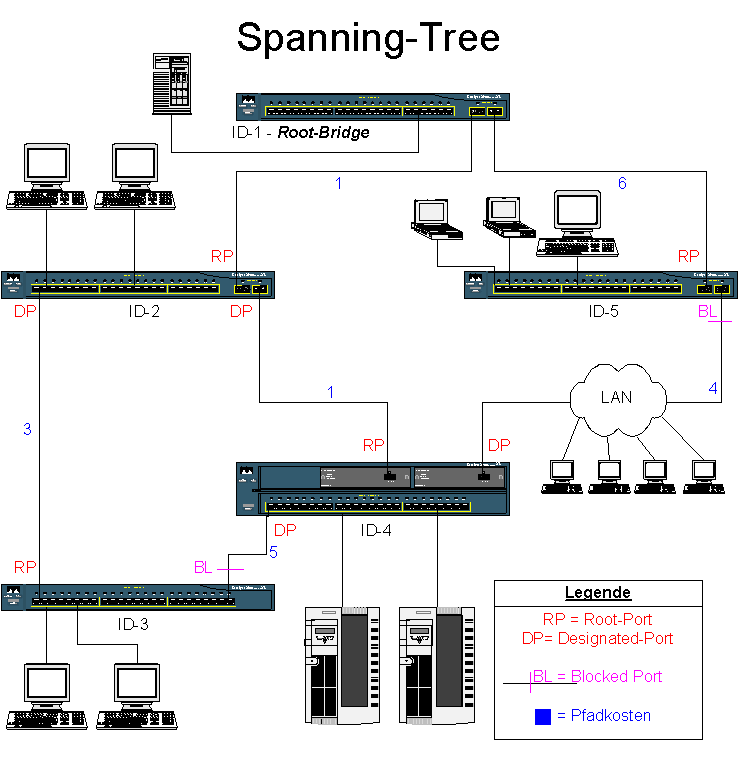
The Spanning Tree Protocol (STP) is a crucial networking protocol designed to prevent loops in networks with redundant paths, ensuring network reliability and stability. Since its inception, STP has evolved into various forms to address different needs and challenges in network environments. In this article, we will delve into the workings of STP, its port states, enabling RSTP, benefits, challenges, and explore two main alternatives: TRILL and SPB.
STP operates by assigning ports to different states, each serving a specific purpose in managing network traffic flow and preventing loops. The main port states in STP are:
Blocking: In this state, the port does not forward frames but listens to BPDUs (Bridge Protocol Data Units) to determine the network topology.
Listening: The port prepares to forward data frames and still listens to BPDUs for any changes in the network topology.
Learning: Here, the port begins to learn MAC addresses by examining incoming frames but still does not forward them.
Forwarding: In the forwarding state, the port actively forwards frames and participates in the data transfer process.
Disabled: This state indicates that the port is administratively disabled and does not participate in STP operations.
To enable Rapid Spanning Tree Protocol (RSTP) on a switch, the following command can be used in Cisco IOS:
switch(config)# spanning-tree mode rapid-pvst
This command configures the switch to use RSTP with Cisco’s Per-VLAN Spanning Tree (PVST) implementation.
Benefits:
– Prevents network loops by intelligently blocking redundant paths.
– Enhances network reliability and stability by ensuring a single active path to each network segment.
– Provides failover capability, allowing networks to continue functioning even if certain links fail.
– Easy to implement and widely supported across various networking equipment and vendors.
Challenges:
– Slow convergence time, especially in large networks, leading to potential network disruptions during topology changes.
– Inefficient bandwidth utilization due to the blocking of redundant links.
– Limited scalability, as STP may struggle to handle complex network topologies and large-scale deployments.
– Vulnerable to misconfigurations and spanning tree-related issues, which can impact network performance and availability.

https://commons.wikimedia.org/wiki/File:Spanning_tree_topology.png
Two main alternatives to STP are:
TRILL (Transparent Interconnection of Lots of Links): TRILL is an emerging protocol designed to address the limitations of STP by providing multi-pathing and loop prevention in large-scale networks. Unlike STP, TRILL uses link-state routing and a distributed forwarding mechanism to optimize network performance and scalability.
SPB (Shortest Path Bridging): SPB is another alternative to STP that aims to simplify network design and improve scalability. SPB leverages the IS-IS (Intermediate System to Intermediate System) routing protocol to calculate shortest paths dynamically and efficiently across the network, eliminating the need for complex spanning tree calculations.
TRILL operates by encapsulating Ethernet frames with a TRILL header, containing routing information such as ingress and egress RBridge (Routing Bridge) addresses. Unlike STP, which relies on a spanning tree algorithm to select active paths and block redundant ones, TRILL utilizes IS-IS routing to compute optimal forwarding paths based on link metrics and network topology.
Key differences between TRILL and STP include:
Multi-pathing: TRILL supports multiple active paths between network segments, allowing for improved bandwidth utilization and load balancing. In contrast, STP typically blocks redundant links to prevent loops, limiting network capacity.
Convergence Time: TRILL offers faster convergence compared to STP, as it leverages dynamic routing protocols to adapt to network changes quickly. STP, on the other hand, relies on timers and periodic BPDU exchanges, leading to longer convergence times in large networks.
Scalability: TRILL is designed to scale efficiently in large and complex network environments, offering better support for virtualized data centers and cloud deployments. STP may struggle to scale due to its inherent limitations in handling redundant links and network complexity.
In conclusion, while STP remains a fundamental protocol for loop prevention in Ethernet networks, alternative solutions like TRILL and SPB offer compelling advantages in terms of scalability, performance, and convergence time, making them viable alternatives for modern network architectures. As network demands continue to evolve, organizations must evaluate their requirements and choose the most suitable protocol to meet their operational needs and future growth.
All Rights Reserved. UVnetworks © 2015 – 2025